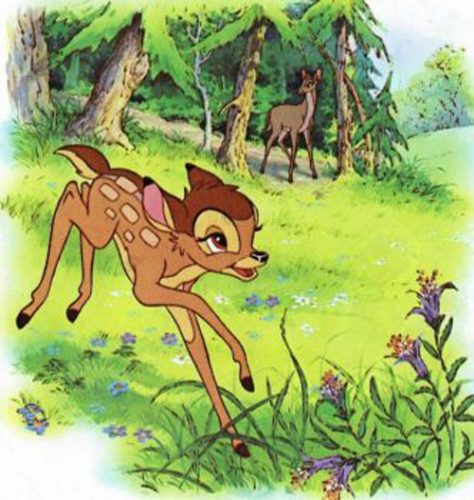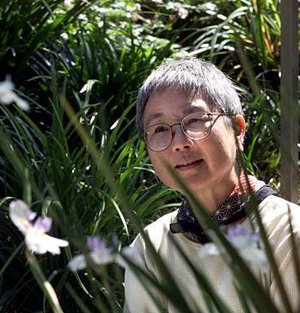Finding Bambi
By Kathering Hisako Glascock
[Katherine Hisako Fukami Glascock (August 31, 1940-October 15, 2017) was a musician, artist, and was best known as a landscape designer. She was married to Baylis Glascock, who we have featured previously on this website, for more than 50 years. In a May 22, 2003, article on her work in the Los Angeles Times, the paper’s garden specialist Emily Green wrote:
[“Katherine Glascock creates gardens that express the true nature of the land and the people who live there. No two are alike, but all bring together strength and elegance.”
[Baylis Glascock has offered us two of her writings, dating from the late 1990s. We have added notes in square brackets on a few of the people she mentions.]
* * *
At the garden on the Malibu coast I saw him in the distance with his friend. As I recognized him they both looked my way. She was tall and graceful; they were a handsome couple. The light from the ocean and the overhead blue outlined them standing in a green wave of gently lilting fine grasses. Seeing them at that distance across the garden, so beautiful, having stopped in the midst of some conversation, both their heads turned toward me like a pair of deer, alert: a sense of formality, a kind of separateness came over me. And I hesitated to go toward them. And to this day I regret having missed the opportunity. How often I have imagined myself stepping through the long sweeps of grasses, greeting them with confidence and a smile, and all of it turning out differently.
Another time it was the memorial for Phil Chandler, who died that summer, who was a mentor to us all. [Philip Edward Chandler (July 3, 1908-July 31, 1995) was a well-known local Los Angeles landscape architect.] Then Robert opened his own small house and garden to our community. We all went to honor Phil, like birds gathering from the far reaches, rustling among the leaves to bury the worn-out corpse of a loved one. Amid the murmur of quiet talk and the oppressive heat of the afternoon our host appeared shy, ill-at-ease. Quiet types, especially sensitive ones, can feel attention acutely, especially unwanted attention, coming their way. So I imagined it might be for Robert that day. Also, I thought guiltily, he might recognize me from that moment at the beach garden as that strange person lurking about. I had hoped to find a moment to speak to him, but instead, in his tiny house filled with so many people, I felt awkward, and imagined too, it was his discomfort I was feeling. I walked through the little rear garden with its small terrace and studied the Upright Rosemary and Epidendrum and Setcreasia and carried home my disappointment.
I hoped for those many years to speak with Robert Fletcher because of something he had said in his presentation of the work of landscape architect Ruth Shelhorn before our local horticultural society. Introducing himself, he mentioned in passing a detail from his childhood. He used only a few words, and so modestly, as a Finding Bambi 2 child presenting a found lizard then going on to play. I wondered how many in the audience that night would remember and give thought to it. When I later asked some of my friends who sat nearby, none could recall it. Because his words caught me by the heart I cannot quote them. I only know he told that he had discovered as a child his own connection with nature and the plant world within the story of Bambi. And so had I many decades ago, except I had forgotten that beginning until being reminded by him, a designer of gardens.
It was in the pages of my Golden Book of Bambi that I saw and felt the visceral power of trees standing tall. Trees towering strong, their trunks and branches coursing with the life of the earth and sun, harboring below the tender grasses and blooming plants, the meadow. And the life of the animals beneath and among their sturdy branches. And then, too, the presence of humans.
One day, at home alone with a cold, I was copying from one page concentrating on a particular mature tree. With my crayons, I felt the power of that tree’s energy in and through its form. Whether it was in the seeing, the drawing, or the combining of them, I was impressed, somehow formed — changed by the moment. Later, I would feel it again in certain moments, especially in painting, as an art student in college; then again, over the years, as a designer in many media. At the age of forty-four I rediscovered it in landscape design: much closer to that childhood experience. But over time I had forgotten Bambi and the forest until that evening when delivered to me within Robert’s quiet introduction.
Back at my parents’ house I found my old Bambi book in the hallway bookshelf. Intact but softly worn with use, its inexpensive cardboard covers still bore its full color illustrations just as I had remembered. But as I leafed from page to page and studied them, especially the ones of the forest, I was astonished by the simplicity and the absence of details and texture. I looked for the power, the vitality I remembered feeling in copying and drawing the trees. Where were they? When a child, was I so moved by these simple illustrations and story to imagine that vitality? I remember having worked especially long on one tree inspired by a page on the left side. After, I was alternately pleased with it and critical of its shortcomings. But even then I was aware that the experience of drawing was completely involving for me and energizing. I knew the experience was somehow transformative.
So when I heard that Robert had died I was pained by my failure to thank him for the great gift of his reminder to me, and of our shared connection with Bambi and the forest. I attended his funeral. So anxious to not miss this last farewell, I arrived a full hour and a half early. I sat alone in the empty dark church. [Robert M. Fletcher (May 30, 1955-October 30, 1995) was another prominent Los Angeles landscape architects.]
His buddy John Greenlee poked his head in from the side of the sanctuary and disappeared. [John Greenlee is the author of The Encyclopedia of Ornamental Grasses and is currently the head of Greenlee & Associates and the Greenlee Nursery.]
I did not speak to any of his friends as it seemed already much too late – so final the closing of the gates. Recently at a design seminar I stood beside John Greenlee. A legend in the field of horticulture, he is handsome, forever tanned, crowned with an unruly bronze thatch of hair, a dazzling smile and charm, truly the JFK of the garden world. With the hope of sharing my small story and passing on my gratitude to Robert via his still living friend, I ventured forth.
“John, do you remember the time Robert Fletcher made the presentation of Ruth Shelhorn’s work before the Southern Cal Hort Society?”
“Aah, yes. Bobbie knew everything. Everything. Every special locale in L.A. He knew every nook and cranny in the local garden scene. We would go to the most far out surprising places to see a plant, climbing over fences of forgotten abandoned mansions to see an unusual tree specimen.”
Ever the raconteur he went bounding off into his memories and before I could share my long-buried tale, we were joined by a small crowd of others. There is no challenging the power of charisma and a well-tuned voice.
I still find myself imagining having a conversation with Robert at an occasion, perhaps in a quiet garden. I would ask him about his memories of his early experiences reading the story of Bambi. Which version of the story was his own? Did he look at it again as an adult? I imagine we could have been friends.
Comments
Leave a Reply
You must be logged in to post a comment.





